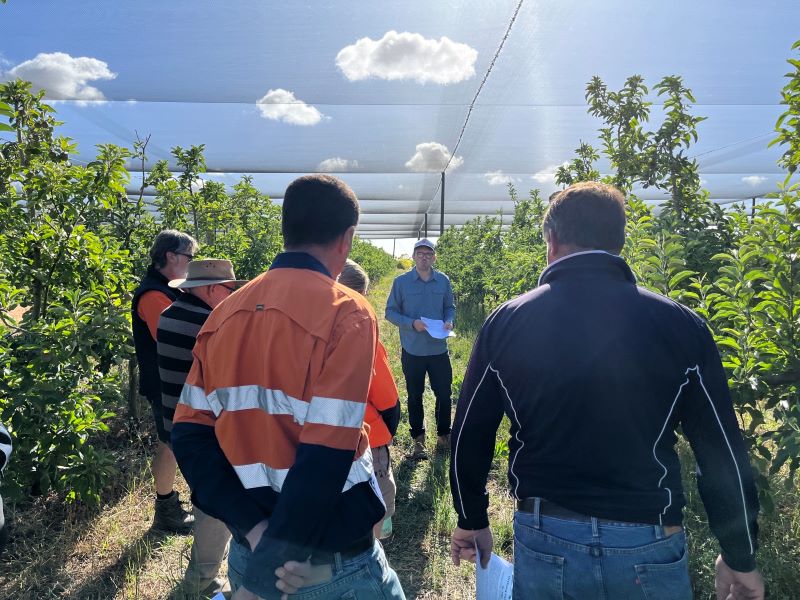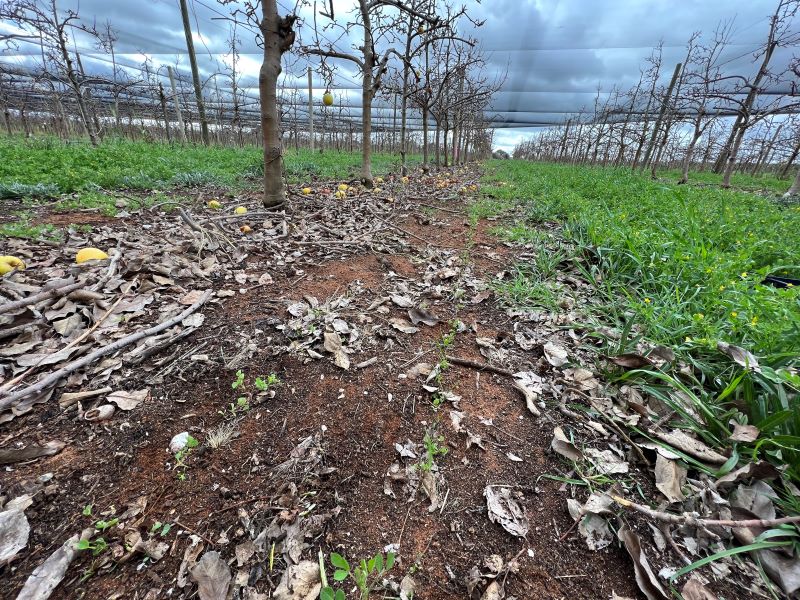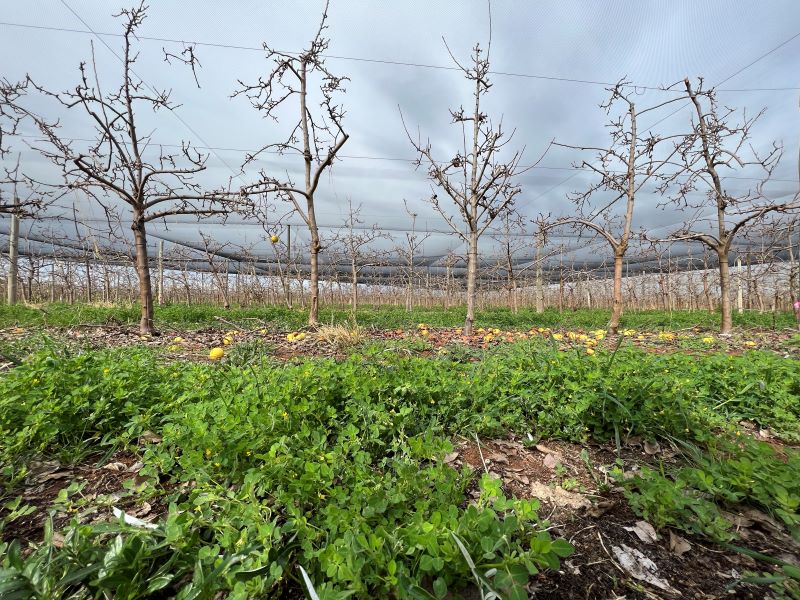Many current practices in agriculture degrade soils and rely heavily on inputs from the farmer to ensure nutrient and water availability meets crop requirements. The apple and pear industries are no different; inter-rows are mown to keep grass low, while the under-trellis is maintained “weed free” via the use of herbicides.
With tightening regulations (including many export markets) and increasing concerns from consumers (i.e. affecting market access), and economic opportunities in carbon sequestration, orchard floor management methods that reduce costs, improve biodiversity and build resilience and sustainability are increasingly sought after.
This project directly exhibits new alternatives to standard orchard floor management methods. By comparing these new ‘ecologically intensive’ methods to ‘business as usual’ approaches, growers will be able to make informed decisions on how to change practice.
Five different orchard floor practices were established. We were able to observe certain trends, specifically, an increase in soil nitrogen and organic carbon concentrations under treatments planted with living cover.
By connecting with growers and agricultural consultants through workshops held at the trial, we were able to provide education on topics of soil health and soil carbon accounting, and demonstrate exactly how cover-cropping methods can be implemented in The Riverland.
Benefits for growers
- Increased soil health: The treatments planted with living cover experienced an increase in soil nitrogen and organic carbon concentrations, indicative of improved soil health.
- Best-practice cover crop establishment: To establish, cover crop seed needs winter rain, especially in a hot, dry climate such as the SA Riverland. Attempting to establish cover crops too late in the season runs the risk of poor germination and emergence.
Project description:
Approach and methods
This project was conceived with several core aims in mind. At its heart, the project sought to extrapolate from significant research conducted in other systems, where Dr Thomas Lines conducted trials to understand the influence of soil management on vineyard floor and grapevine health.
Work of this nature is vital in the extreme environments of The Riverland, where growers are highly dependent on herbicides for maintaining bare earth. In these climates, with high volume production and minimal economic margin, growers need support to transition to more resilient and sustainable systems. Moreover, the adoption of ‘alternative practices’ is, above all, a social issue – a human activity – and thus requires both evidential bases and consistent outreach and communication. Accordingly, this project was undertaken with regional outreach and communication in mind.
Over the course of a year, the trial experimented with five orchard floor management practices:
- Herbicide (tree-row) – the ‘business as usual’ control treatment
- Volunteer sward (whole floor)
- Pollinator mix (whole floor)
- Medic and ryegrass (whole floor)
- Tall fescue, Festuca arundinacea (tree-row).
Soil sampling and apple harvesting were conducted, with samples of each processed in a laboratory and analysed for certain physical, chemical and biological properties.
This approach allowed researchers to better understand the influence of various orchard floor management practices on the ecological intensification of the orchard – that is, how various physical, chemical and biological properties can function synergistically to reduced human input (akin to a natural system).
Results
After one year of trial, the research team did not expect to find statistically significant results, but were able to discern certain trends. Notably, they observed a trend of increased soil nitrogen and organic carbon under treatments of living cover, especially those planted with medic/ryegrass and fescue. Given longer, these would be expected to increase and separate from the herbicide treatment, owing to the living cover providing a photosynthetic pathway to allow atmospheric carbon to become assimilated and translocated to the roots and soil. Moreover, results from previous studies have shown improved soil structure, water infiltration and water holding capacity under living cover.
As expected, no statistically significant differences were observed in this trial, but we would expect to see these present with more time.
Grower engagement
Over the course of the project, two workshops were conducted. Attendance was small but engaged, with notable regional interest. Grower views and concerns were heard and discussed.
At both open days, Dr Lines explained the rationale behind the use of alternative practices, presenting data from both this current trial and previous work of a similar nature. The advice and research were framed in the context of the industry and the region – one affected by extreme climates.
A survey was used to better understand growers’ knowledge surrounding soil health and the use of alternative practices. A flyer was distributed to attendees highlighting the background and methodology of the trials, with some key points on implementing certain practices, including seeding regimes and management to achieve the best emergence and maintain cover.
The results and outreach from this trial offer growers an understanding of how several orchard floor management practices influence both soil properties and apple yield and quality. Providing information on several strategies allows different growers to find and implement the correct practice for their orchard and achieve the desired outcome. Outcomes may alter depending on apple cultivar or soil type.
The importance of conducting these trials in the Riverland itself offers regional specificity and provides relevant information on treatment influence and treatment implementation for those wishing to reduce inputs and enhance the ecological intensification of their orchard system. The development of flyers ensures that relevant information is distilled into a short, readable format that can be expanded through further reading and communication with Dr Lines and his team.
Key achievements and results:
This trial was established for several interrelated reasons.
First, it provided valuable on-site demonstrations and outreach to growers and interested stakeholders. Over the course of the one-year trial, Dr Lines conducted two open days where growers and stakeholders were invited to attend and observe a presentation highlighting the rationale behind the project, methodology of treatment establishment and results after one year of trial establishment.
Second, the trial sought to quantify the effects of different orchard floor management practices on both soil and apple health, as well as provide valuable access to alternative weed management practices through on-farm workshops. The term ‘health’ in relation to soil and apples is broad, and in this context it pertains to certain physical, chemical and biological metrics that, from a holistic perspective, may be grouped to establish a baseline for from which we can monitor, assess and report.
From a scientific perspective, the trial builds on previous work in similar perennial systems, where longer-term trials showed the significant and beneficial effects of contrasting management practices on vineyard soil and grapevine metrics.
Outcomes
Although it is difficult to draw conclusions on data after only one year of trial establishment, there are important points to take away.
Cover crop establishment
To adhere to best practice in terms of cover crop establishment, timing is crucial. Sowing cover crop seed requires winter rain to establish, especially in a hot, dry climate such as the South Australian Riverland. Attempting to establish cover crops too late in the season runs the risk of poor germination and emergence, owing to lower soil moisture content and dry, impacted soils hampering root and shoot growth.
Soil health
Furthermore, previous evidence from vineyard trials showed that in hot, dry climates, overly vigorous cover crops, such as fescue, may prove detrimental to soil water dynamics. In contrast, a combination cover crop, such as medic/ryegrass, may offer benefits with regards to nutrient cycling, especially soil nitrogen and soil organic carbon concentrations.
Benefits to industry and potential for adoption
Due to the relatively small amount of data collected from this trial, conclusions must be treated with caution – adoption requires evidence, which requires time. However, it was possible to extrapolate from data collected in previous trials.
The trial demonstrated the relative ease with which orchard floor cover can be established, as well as introduced methods by which this might be carried out. Therefore, adoption need not require an entire orchard to be covered to understand the benefits. Growers may opt to ‘test the waters’, sowing partial cover, while maintaining bare earth elsewhere.
The industry benefits of adopting orchard floor cover include an immediate reduction in herbicide use, which may allow soils to undergo ‘ecological intensification’. In this scenario, living covers provide certain ecosystem services to the orchard, enhancing nutrient cycling and improving soil structure and porosity, leading to enhanced infiltration and water-holding capacity in the medium to long term.
Further information:
Project case study
Project Technical Report
Enhancing orchard soils – Technical Report
Workshop handouts
Further information
For further information on this and other weed management trials in The Riverland and across South Australia, Dr Thomas Lines can be reached at Thomas.lines@adelaide.edu.au and he will be more than happy to provide flyers, other resources, or specific advice on how best to manage soil health in your agricultural system.
Project Images











